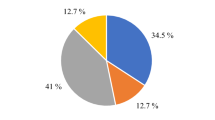Abstract
This study proposes a model that estimates optimal expected temperature for thermal comfort at various levels of relative humidity, wind speed, mean radiation temperature, metabolic rate, and clothing insulation, while improving the variables of the mean radiation temperature. By including the results of numerical and observational data testing, the improved model considers mean radiant temperatures more comprehensively than the previous model. Changes in expected temperatures for thermal comfort at various mean radiation temperatures showed that the outdoor temperature must decrease as the length of outdoor exposure increases. The expected temperature for thermal comfort must be lower at higher metabolic rates. The expected temperature does not change as wind speed increases when the mean radiant temperature is low. However, as mean radiant temperature increases, the expected temperatures change depending on the wind speed.
Similar content being viewed by others
References
Ali-Toudert, F., and H. Mayer, 2006: Numerical study on the effects of aspect ratio and orientation of an urban street canyon on outdoor thermal comfort in hot and dry climate. Build Environ, 41, 94–108.
ASHRAE, 2001: ASHRAE Fundamentals Handbook 2001 (SI Edition). American Society of Heating, Refrigerating, and Air Conditioning Engineers, Atlanta, GA.
ASHRAE, 2005: ASHRAE Handbook Fundamentals (SI Edition). American Society of Heating, Refrigerating, and Air Conditioning Engineer, Atlanta, GA.
Auliciems, A., and S. V. Szokolay, 1997: Thermal comfort.University of Queensland, Brisbane, Australia.
Bedford, T., and C. G. Warner, 1934: The Globe Thermometer in studies of heating and ventilation. J. Hyg-Cambridge, 34, 458–473.
Belding, H. S., 1970: The search for a universal heat stress index, In: Physiological and behavioral temperature regulation. Charles C Thomas, Springfield, 193–202.
Brebner, D. F., D. M. Kerslake, and J. L. Waddell, 1956: The diffusion of water vapor through human skin. J. Physiol., 132, 225–231.
Buskirk, E. R., 1960: Problems related to the caloric cost of living. B. New York Acad. Med., 26, 365.
Cheng, V., E. Ng, C. Chan, and B. Givoni, 2012: Outdoor thermal comfort study in a sub-tropical climate: a longitudinal study base in Hong Kong. Int. J. Biometeorol., 56, 43–56.
Choi, S. J., 2012: An Obervatory study for the Mitigation of Extreme heat Impact. M. S. Thesis. Gimhae, Inje University (Korean).
Epstein, Y., and D. S. Moran, 2006: Thermal comfort and the heat stress indices. Ind. Health, 44, 388–398.
Fanger, P. O., 1967: Calculation of thermal comfort: Introduction of a basic comfort equation. ASHRAE Trans., 73, (II): III.4.1–III4.20.
Fanger, P. O., 1970: Thermal comfort: analysis and application in environmental engineering. New York, McGraw-Hill, 244 p.
Gagge, A. P., and Y. Nishi, 1976: Physical indices of the thermal environment. ASHRAE J18, 47–51.
Haldane, J. S., 1905: The influence of high air temperature. J. Hyg-Cambridge, 5, 494–513.
Havenith, G., 2003: The physiology of heat related illness/mortality. cCASHh Workshop on Vulnerability to Thermal Stresses, 5–7 May, Freiburg, Germany.
Havenith, G., I. Holmer, E. A. den Hartog, K. C. Parsons, 1999: Clothing evaporative heat resistance-proposal for improved representation in standards and models. Ann. Occup. Hyg., 43, 339–346.
Holmer, I., 1984: Required clothing insulation (IREQ) as an analytical index of cold stress. ASHRAE Trans 90, 1116–1128.
Huang, J., 2007: Prediction of air temperature for thermal comfort of people in outdoor environments. Int. J. Biometeorol., 51, 375–382.
ISO, 1993: ISO/TR 11079: Evaluation of cold environments determination of required clothing insulation (IREQ) (Technical Report 11079). International Organization for Standardization, Geneva.
Kim, S. C., 2008: Study for globe temperature characteristic and practical use way in downtown area on Summer season. M. S. Thesis. Gimhae, Inje University (Korean).
Kim, E. B., 2013: Evaluation of Human-body Effect and Potential Risk Forecasting Models by High Temperature Environment. Ph. D. Thesis. Gimhae, Inje University (Korean).
Kuehn, L. A., R. A. Stubbs, and R. S. Weaver, 1970: Theory of the globe thermometer. J. Appl. Physiol., 29, 750–757.
Larsen, R. I., 1973: An Air Quality Data Analysis System for Interrelating Effects. Standards and Needed Source Reductions. J. Air Pollu. Control Assoc., 23, 933–940.
Levine, J. A., 2004: Nonexercise activity thermogenesis (NEAT): environment and biology. Am. J. Physiol.-Endoc. M., 286, 675–685.
McCullough, E. A., B. W. Jones, and T. Tamura, 1989: A data base for determining the evaporative resistance of clothing. ASHRAE Trans, 95, 316–328.
Park, J. K., W. S. Jung, S. C. Kim, and G. U. Park, 2008: On the characteristics of globe temperature variation observed at downtown in summer season. J. Environ. Sci. Int., 17, 907–918 (Korean).
Park, S. K., 2011: Human-Urban radiation exchange simulation model. Ph. D. thesis. University of Victoria.
Parsons, K. C., 1999: International standards for the assessment of the risk of thermal strain on clothed workers in hot environments. Ann. Occup. Hyg., 43, 297–308.
Parsons, K. C., 2003: Human thermal environments. 2nd Ed., Taylor & Francis, London, 258–292.
Parsons, K. C., G. Havenith, I. Holmer, H. Nilsson, and J. Malchaire, 1999: The effects of wind and human movement on the heat and vapour transfer properties of clothing. Ann. Occup. Hyg., 43, 347–352.
Passmore, R., and J. V. G. Durnin, 1967: Energy, work and leisure. Heinemann Educational Books, London.
Thorsson, S., F. Lingberg, I. Eliasson, and B. Holmer, 2007: Different methods for estimating the mean radiant temperature in an outdoor urban setting. Int. J. Climatol., 27, 1983–1993.
Vernon, H. M., 1932: The globe thermometer. Proc. Inst. Heating and Ventilating Engineers, 39, 100–104.
Webb, P., 1964: Bioastronautics data base. NASA.
Author information
Authors and Affiliations
Corresponding author
Rights and permissions
About this article
Cite this article
Kim, EB., Park, JK. Proposal for a heat balance model tailored to the Korean peninsula. Asia-Pacific J Atmos Sci 50 (Suppl 1), 657–667 (2014). https://doi.org/10.1007/s13143-014-0053-2
Received:
Accepted:
Published:
Issue Date:
DOI: https://doi.org/10.1007/s13143-014-0053-2




